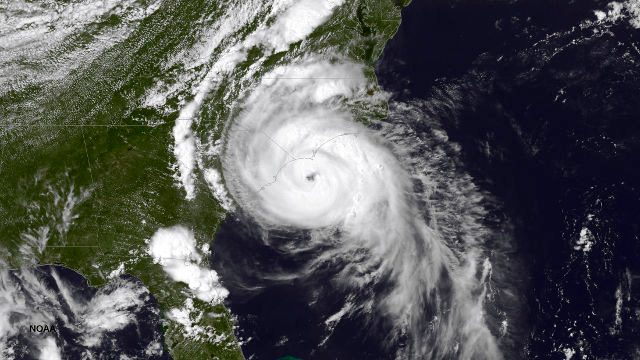SUMMARY
This is AI generated summarization, which may have errors. For context, always refer to the full article.

MIAMI, USA – Hurricane Arthur, packing 100 mile per hour (160 km/h) winds and drenching rains, struck a glancing blow off the US east coast Friday, July 4, before churning northward.
As dawn broke on a disrupted July 4 Independence Day holiday for tens of thousands of vacationers, television footage showed fierce winds and horizontal rain in the resort region of the Outer Banks of North Carolina where the storm made landfall late Thursday.
Trees bent wildly in the gusting rain as gushing streams of water flowed in streets.
No damage assessment or injury toll was immediately available, however.
The US National Hurricane Center said the first hurricane of the Atlantic season carried potential for big and damaging waves and powerful tidal surges.
It first hit the Outer Banks, a series of long and thin barrier islands. Tens of thousands of people had hoped to enjoy the US Independence Day holiday there.
Some evacuations had been ordered as the hurricane approached. It finally came ashore as a category two hurricane, on a scale in which five is the highest.
In its 0900 GMT (5:00 pm Philippine time) update, the National Hurricane Center said Arthur had bounced back offshore and headed northward well off the coast as it moved toward the mid-Atlantic region, toward New England and Nova Scotia, Canada.
The hurricane will weaken over the next two days into a post-tropical depression Friday night or Saturday, the Miami-based center said.
North Carolina state Governor Pat McCrory said emergency preparation efforts had been made more complicated by the arrival of thousands of tourists who do not know the local roads well.
Power cuts and emergency shelters
Heavy rain and strong winds lashed the North Carolina coast.
Thousands of people were already without power in North Carolina, news reports said, and there was localized flooding in areas including the coastal city of Wilmington.
“Our main issue is the health and safety of our citizens and those people who are visiting North Carolina,” McCrory said.
Emergency declarations were issued by several counties in the southern state, which opened emergency shelters and ordered evacuations in low-lying areas.
“As the hurricane moves north, more counties are likely to declare a state of emergency,” McCrory added.
National Hurricane Center forecasters warned of “large and damaging waves” and cautioned: “Preparations to protect life and property should have already been completed.”
But, as always, there were holdouts.
“I don’t take these storms lightly, but I’ve never left during a hurricane,” Renee Cahoon, 58, the former mayor of Nags Head on the Outer Banks, told the Los Angeles Times. She owns a grocery story and has lived in a beachfront home for more than 40 years. She plans to reopen her shop when the storm clears Friday.
No ‘stupid hat’
McCrory Wednesday urged residents and tourists to use common sense, to stay out of the water and out of harm’s way, with storm surges of up to five feet (1.5 meters) predicted.
Up to 8 inches (20 centimeters) of rain were expected in coastal areas.
As many as half a million visitors had been expected in the coastal Carolinas for the national holiday, the region’s biggest tourist weekend.
Authorities issued a mandatory evacuation order for Hatteras Island and a voluntary evacuation order for Ocracoke Island, both in North Carolina’s Outer Banks, CNN reported.
But it was not just North Carolina — where tornado warnings were activated in some areas — that was bracing for Arthur’s impact.
The storm threatened to scuttle traditional Independence Day weekend picnics, parades and fireworks displays for millions of Americans along the East Coast, as far north as New England.
Dangerous storm swells were expected as far south as central Florida, weather officials said.
The Atlantic hurricane season began June 1 and runs through November 30. – Rappler.com
Add a comment
How does this make you feel?
There are no comments yet. Add your comment to start the conversation.